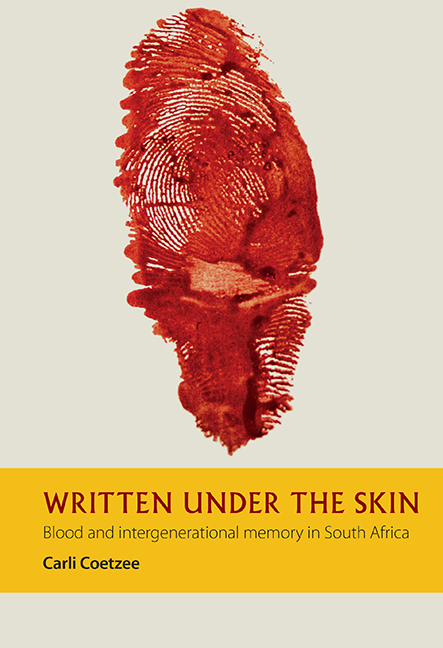Book contents
- Frontmatter
- Dedication
- Contents
- Preface
- Introduction: Piercing the Skin of the Present
- Part I
- 1 Reading Mandela's Blood: The Transition, and the Cell as Portal into Bloodless Time
- 2 He Must Not Circulate: Eugene de Kock's Blood Relations and his Prison Visitors
- 3 Ruth First's Red Suitcase: In and Out of the Strongroom of Memory
- 4 A Life Transplanted and Deleted: Hamilton Naki and his Archivists
- Part II
- Bibliography
- Index
- Miscellaneous Endmatter
4 - A Life Transplanted and Deleted: Hamilton Naki and his Archivists
from Part I
Published online by Cambridge University Press: 26 March 2019
- Frontmatter
- Dedication
- Contents
- Preface
- Introduction: Piercing the Skin of the Present
- Part I
- 1 Reading Mandela's Blood: The Transition, and the Cell as Portal into Bloodless Time
- 2 He Must Not Circulate: Eugene de Kock's Blood Relations and his Prison Visitors
- 3 Ruth First's Red Suitcase: In and Out of the Strongroom of Memory
- 4 A Life Transplanted and Deleted: Hamilton Naki and his Archivists
- Part II
- Bibliography
- Index
- Miscellaneous Endmatter
Summary
The first successful human-to-human heart transplant, performed in Groote Schuur Hospital in Cape Town on 3 December 1967, has received a great deal of scholarly and popular attention. The year 2017, when I was finalising this chapter, marked the 50th anniversary of the operation, and with the opening of a museum called the Heart of Cape Town, housed in the very same hospital space where the operation took place, yet a new context has been created for understanding these events. The museum lovingly recreates, with a mixture of archival materials (such as letters, telegrams of congratulations and items that belonged to Christiaan Barnard), the events of 3 December 1967. Barnard's white rubber theatre boots were recently brought to the museum by a nurse who had kept them since the operation (Makwabe 2013). News reports covered this story (on television as well as in the press), the return of the boots emphasising the completeness and veracity of the archive, but also illustrating the emotional weight of the museum, with each donation reactivating the life of the museum in the public eye (and heart, one is tempted to add).
The museum's accuracy and truthfulness is stressed by guides and its website (http://www.heartofcapetown.co.za/), as well as by the labels and information that guide one through the rooms. The most fascinating aspect of the museum is the fake moments in the truthful reconstruction. There are two significant anomalies, both of which disturb the careful date stamp of the recreation. The first interruption in the date stamp is the way that the bedroom of Denise Darvall (the donor of the historic heart) has been recreated. The bedroom includes elements from an imagined future moment, extending beyond the death of the young woman, and creating for us a space that she might have inhabited had she not died. Descriptions of Darvall typically linger on her beauty and her youth, emphasising also the smallness of the heart inside her girlish body. The reconstruction of her bedroom in the museum is faithful in its period details, but nevertheless creates the bedroom not as it was, but as it might have become, extending her life beyond the premature death. Darvall had made some rather child-like drawings of dresses (the drawings are on display), and these have been interpreted by a tailor and made up into dresses that we see in the bedroom.
- Type
- Chapter
- Information
- Written under the SkinBlood and Intergenerational Memory in South Africa, pp. 81 - 100Publisher: Boydell & BrewerPrint publication year: 2019



